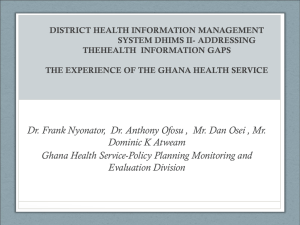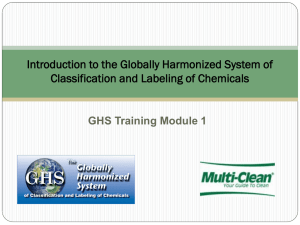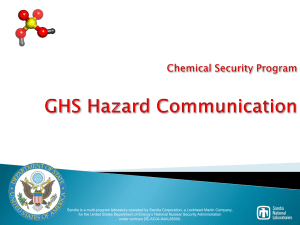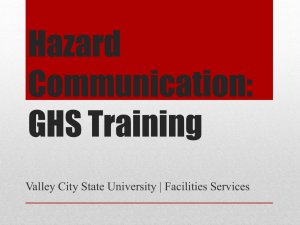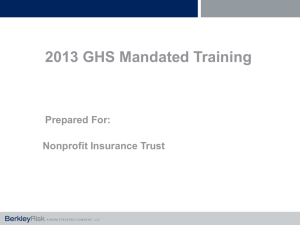UN/SCEGHS/19/INF
advertisement
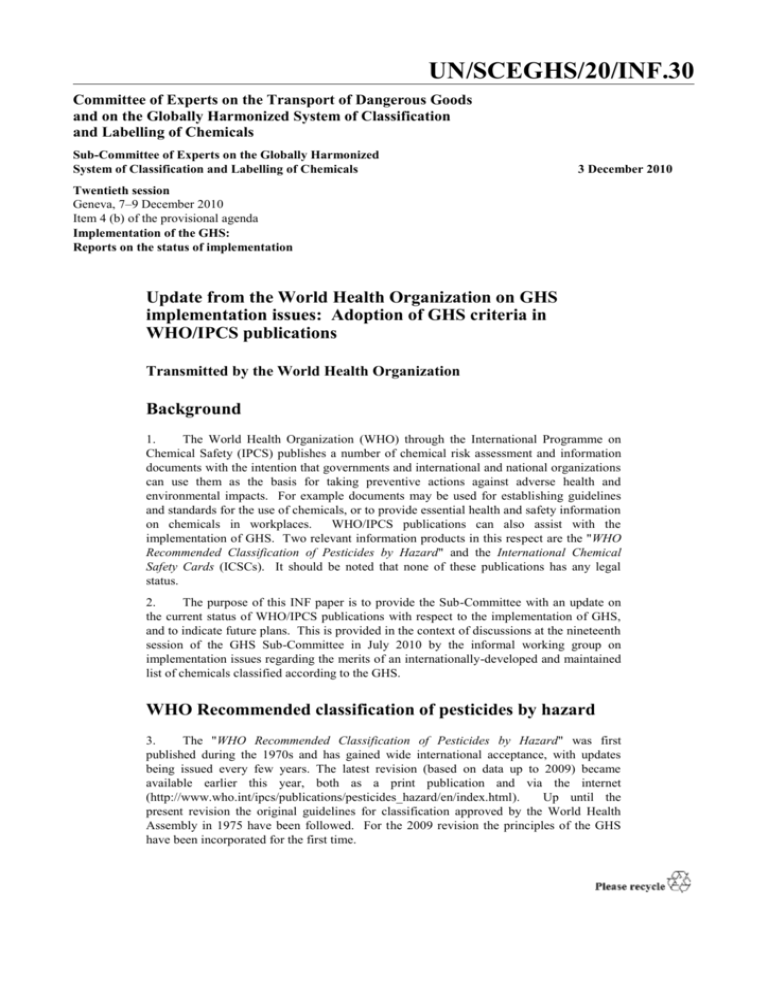
UN/SCEGHS/20/INF.30 Committee of Experts on the Transport of Dangerous Goods and on the Globally Harmonized System of Classification and Labelling of Chemicals Sub-Committee of Experts on the Globally Harmonized System of Classification and Labelling of Chemicals 3 December 2010 Twentieth session Geneva, 7–9 December 2010 Item 4 (b) of the provisional agenda Implementation of the GHS: Reports on the status of implementation Update from the World Health Organization on GHS implementation issues: Adoption of GHS criteria in WHO/IPCS publications Transmitted by the World Health Organization Background 1. The World Health Organization (WHO) through the International Programme on Chemical Safety (IPCS) publishes a number of chemical risk assessment and information documents with the intention that governments and international and national organizations can use them as the basis for taking preventive actions against adverse health and environmental impacts. For example documents may be used for establishing guidelines and standards for the use of chemicals, or to provide essential health and safety information on chemicals in workplaces. WHO/IPCS publications can also assist with the implementation of GHS. Two relevant information products in this respect are the "WHO Recommended Classification of Pesticides by Hazard" and the International Chemical Safety Cards (ICSCs). It should be noted that none of these publications has any legal status. 2. The purpose of this INF paper is to provide the Sub-Committee with an update on the current status of WHO/IPCS publications with respect to the implementation of GHS, and to indicate future plans. This is provided in the context of discussions at the nineteenth session of the GHS Sub-Committee in July 2010 by the informal working group on implementation issues regarding the merits of an internationally-developed and maintained list of chemicals classified according to the GHS. WHO Recommended classification of pesticides by hazard 3. The "WHO Recommended Classification of Pesticides by Hazard" was first published during the 1970s and has gained wide international acceptance, with updates being issued every few years. The latest revision (based on data up to 2009) became available earlier this year, both as a print publication and via the internet (http://www.who.int/ipcs/publications/pesticides_hazard/en/index.html). Up until the present revision the original guidelines for classification approved by the World Health Assembly in 1975 have been followed. For the 2009 revision the principles of the GHS have been incorporated for the first time. UN/SCEGHS/20/INF.30 4. The WHO Classification scheme is intended to distinguish between the more and the less hazardous forms of each pesticide, and is based primarily on the acute oral or dermal toxicity of the technical form of the active substance. A method for establishing the classification of formulations is also included. Pesticides are classified into one of five Classes (Ia, Ib, II, III and U) with descriptions ranging from "Extremely Hazardous" to "Unlikely to present acute hazard". Many organizations refer to the Class Ia and Ib pesticides as 'Highly Hazardous Pesticides' (HHPs). The classification criteria guidepoints (cut-off levels) for the Classes were originally established during the 1970s. The classification of certain pesticides is adjusted to take account of severe hazards to health other than acute toxicity where necessary. These hazard Classes have become long established and are often referred to in national pesticide registration schemes, scientific publications and guidance made available by International Organizations (e.g. FAO, World Bank). 5. The principles for classification of pesticides established originally by the World Health Assembly envisaged that the classification criteria might need to be developed with time and increasing experience. WHO has been requested (by a number of interested parties e.g. The WHO/FAO Joint Meeting on Pesticide Management) to incorporate GHS information within this publication. Furthermore, WHO Chemical Risk Assessment publications have a role to play in assisting with the implementation of international agreements such as the GHS. For the 2009 revision the GHS Acute Toxicity Hazard Categories for acute oral or dermal toxicity have been taken into account in developing revised classification criteria. 6. The original WHO classification scheme applied different LD 50 cut-off values for the classification criteria for pesticides in solid form or in liquid form. This distinction is not made in the GHS. The revised WHO classification scheme for the 2009 revision also no longer makes a distinction between solid and liquid pesticides. 7. The revised WHO classification scheme is shown below: LD50 for the rat Class (mg/kg body weight) Oral Dermal < 50 Ia Extremely hazardous <5 Ib Highly hazardous 5 - 50 50 - 200 II Moderately hazardous 50 - 2000 200 - 2000 III Slightly hazardous Over 2000 Over 2000 U Unlikely to present acute hazard 5000 or higher 8. The classification criteria represent a compromise between the former cut-off values for solid and liquid pesticides. The GHS cut-off values for Category 2 and Category 3 are lower than the values which applied to liquid pesticides under the former WHO scheme. Some liquids previously allocated to Class Ib (specifically pesticides with oral LD 50 values in the range 50-200 mg/kg bw) would be placed in the "lower" GHS Category 3. This is significant because many organizations and some governments target their pesticide management policies at the Class Ia and Ib pesticides. To avoid the situation of pesticides receiving a reduced (i.e. less hazardous) classification as a result of the change in criteria, the classification of a limited number of pesticides was adjusted so that they remained in Class Ib. 2 UN/SCEGHS/20/INF.30 9. In addition to the revised WHO Classification, the GHS Acute Toxic Hazard Category according to GHS criteria is also presented in the table of information for each pesticide. Making GHS classifications available in this publication should assist with the implementation of GHS in countries which utilise this publication for pesticide management. 10. The current WHO Classification publication (and all previous editions) are based mainly on acute hazard only. For future revisions of this document there is the potential to develop an enhanced classification scheme which would be based on a wider range of GHS classification criteria. A classification scheme is envisaged involving a matrix approach where a single WHO Hazard class could be allocated to a pesticide based on particular combinations of health hazards, which could include carcinogenicity, mutagenicity, reproductive toxicity and/or specific target organ toxicity. It is further envisaged that a single WHO Hazard class derived in this way could be effectively used in combination with colour codes for hazard communication on pesticide labels, as used in countries where the standard of literacy is variable. The development of an entirely new Classification scheme of this nature would require extensive expert input and consultation, and would be dependent on sufficient resources being made available. 11. The resources which would be required to determine full GHS health classifications for all pesticides currently featured in the publication (at least 600 active substances) will not be available. However, it is intended to prioritise the two most hazardous categories of pesticides in the current system (approximately 90 active substances) to make full GHS health classifications available, with further pesticides to be incorporated as resources allow. The International Chemical Safety Cards (see below) represent a potential mechanism by which GHS classifications could be determined. 12. The WHO Recommended Classification of Pesticides publication will be developed for future revisions to allow the presentation of as wide a range of GHS classification information as possible (for information purposes), independently of the development of the WHO Classification scheme. International Chemical Safety Cards 12. International Chemical Safety Cards (ICSCs) provide essential health and safety information on chemicals, including information on intrinsic hazards, first aid and firefighting measures and precautions relevant to storage, spillage, transport and disposal. ICSCs are prepared by Occupational Health and Safety Institutions and are finalized by a peer-review meeting in a collaborative programme between WHO, the International Labour Organization and the European Union. ICSCs on more than 1400 chemicals are available (written in English) via the Internet, and the majority of ICSCs have also been translated into 15 other languages. 13. ICSCs currently carry classification and labelling information for chemicals which have been classified in the European Union (under the former Dangerous Substances Directive). Since 2006 ICSCs which have been newly prepared or updated have had GHS classifications added. In this way information on GHS is being made available to a range of users including at workplace level, especially in developing countries. 14. It is intended to use ICSCs to develop GHS classifications for the hazardous classes of pesticides as described above. Currently ICSCs have been created for approximately 40 pesticides in the two most hazardous classes. Creating ICSCs (with GHS classifications) for the remaining hazardous pesticides will be given priority in the selection of chemicals for new ICSCs over the next two years. The existing ICSCs for hazardous pesticides will similarly be prioritised for update where GHS classifications are absent. 3 UN/SCEGHS/20/INF.30 15. The creation of ICSCs for pesticides can be limited by the availability of data, which is often proprietary and not routinely published in the scientific literature. The successful completion of ICSCs for pesticides, and the presentation of GHS classifications for pesticides within the WHO Recommended Classification of Pesticides by Hazard may require the cooperation of industry and other stakeholders who may hold the necessary information. 4
